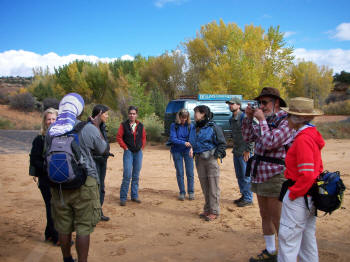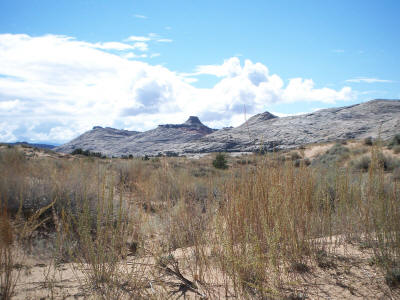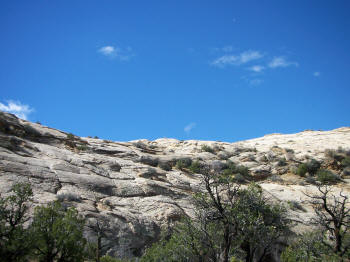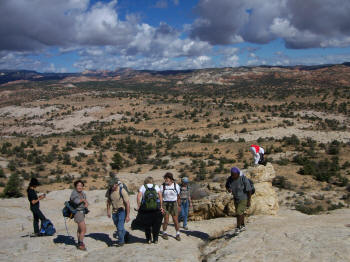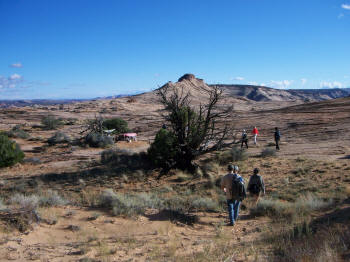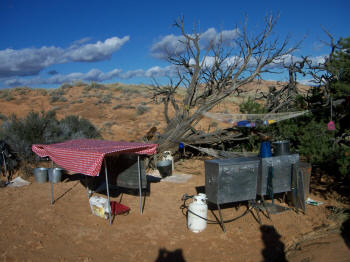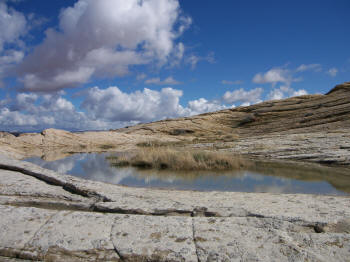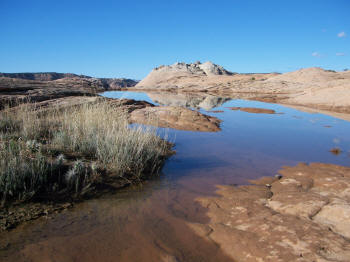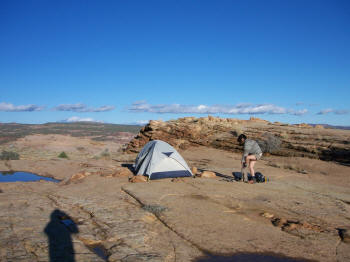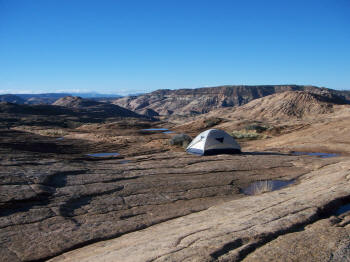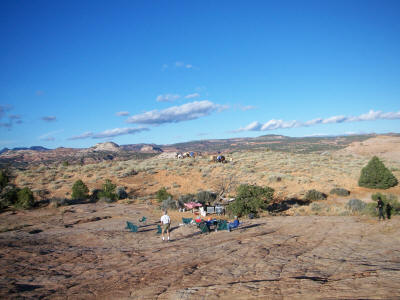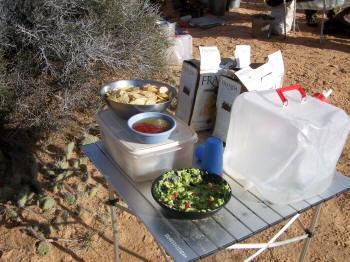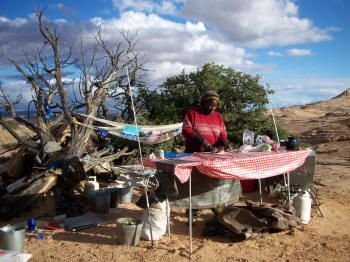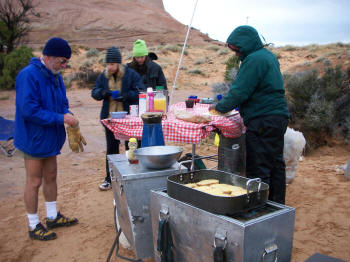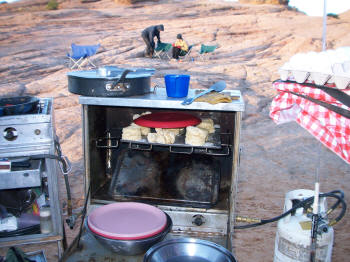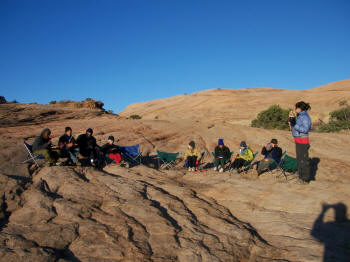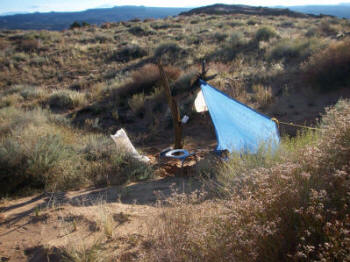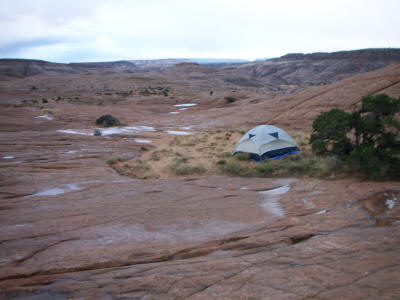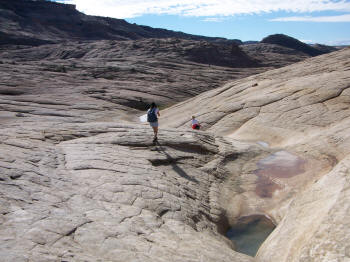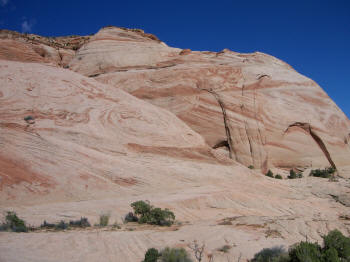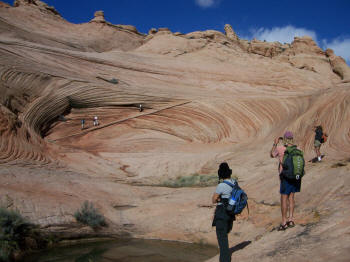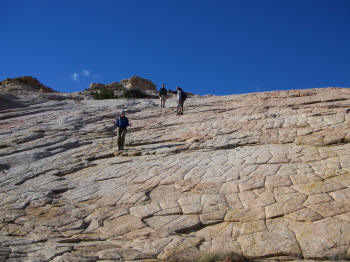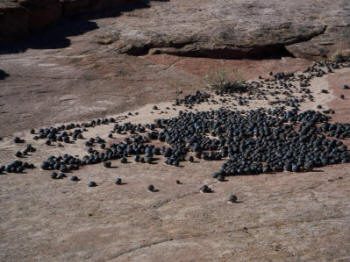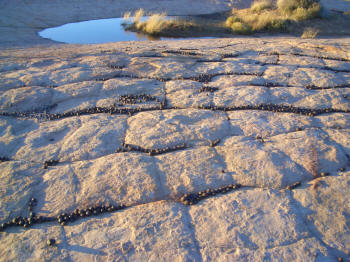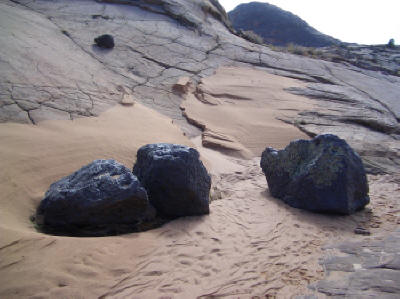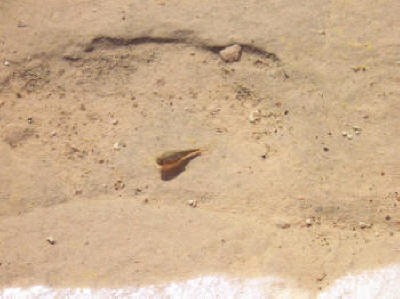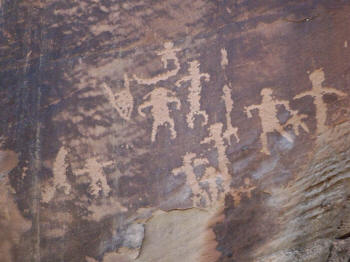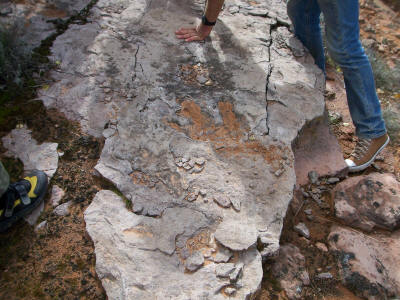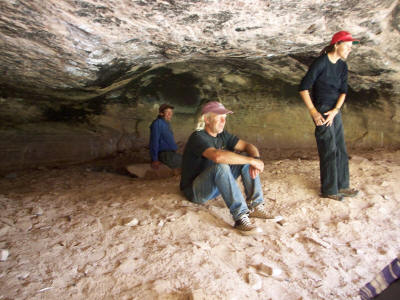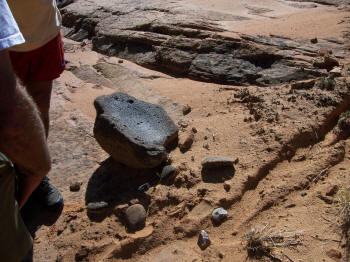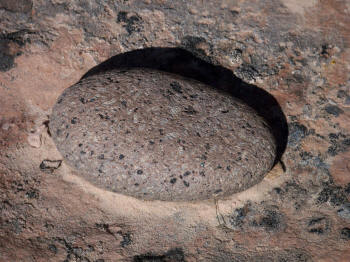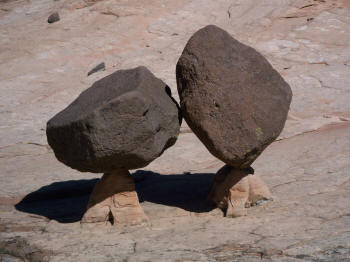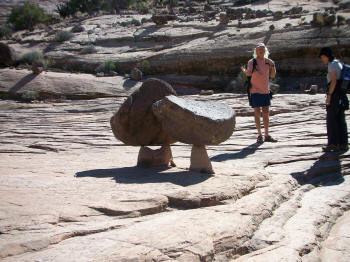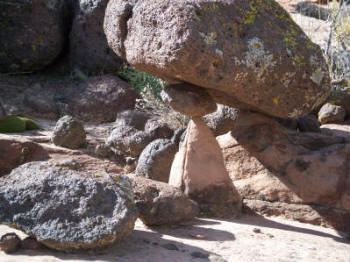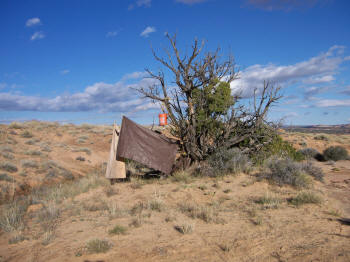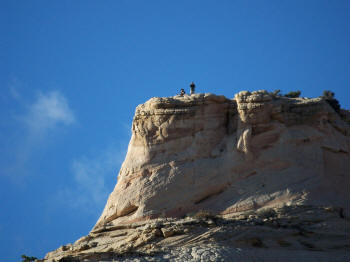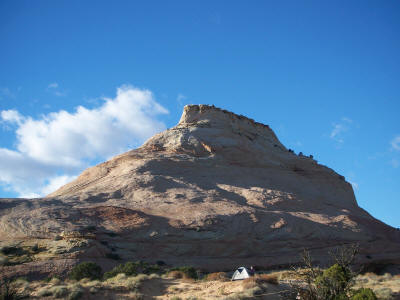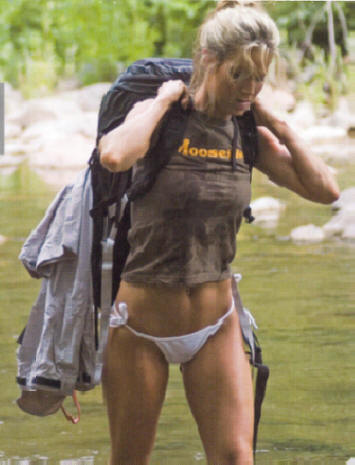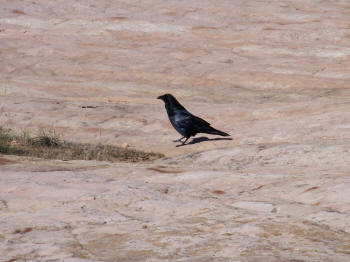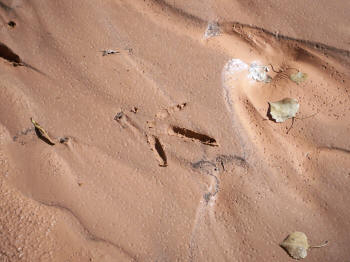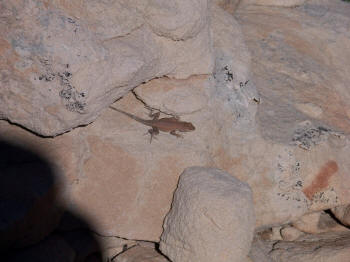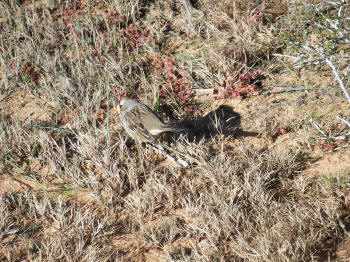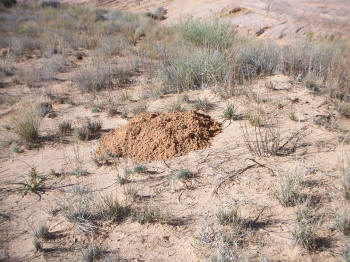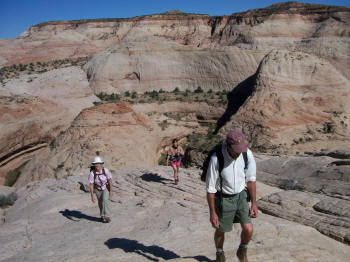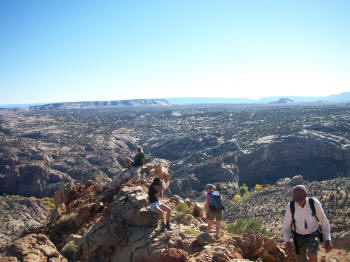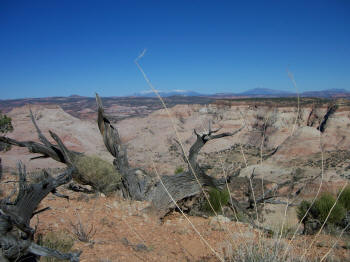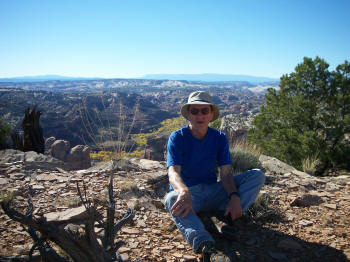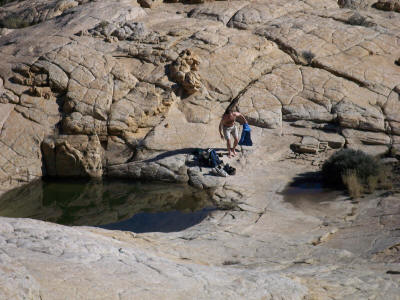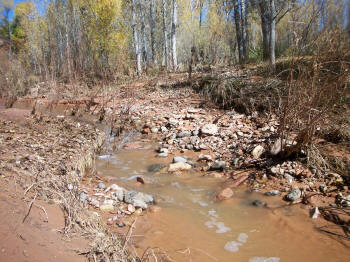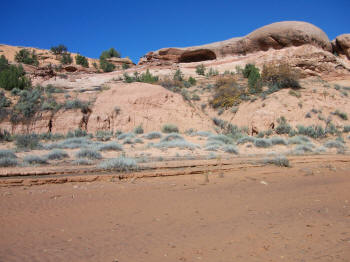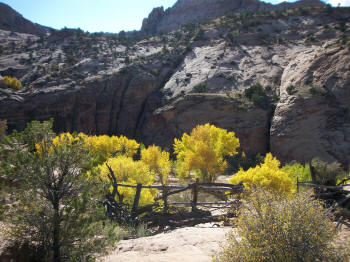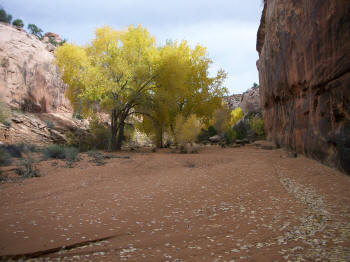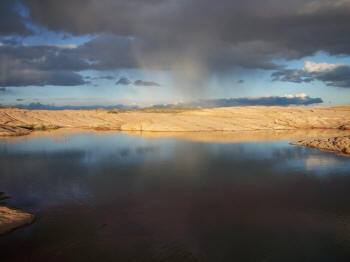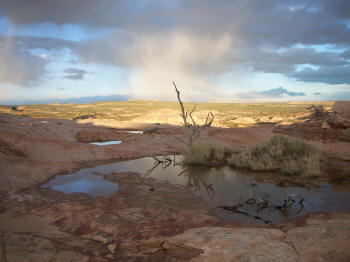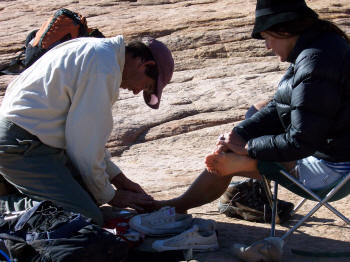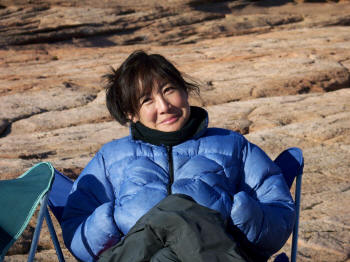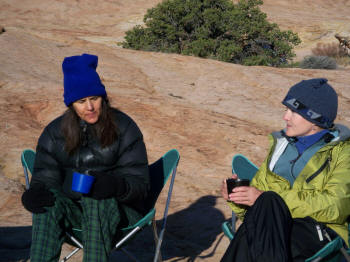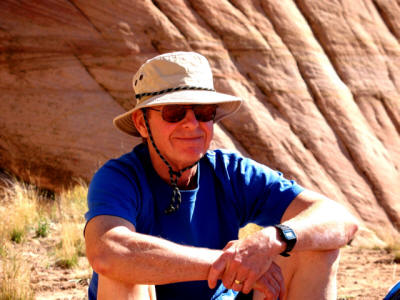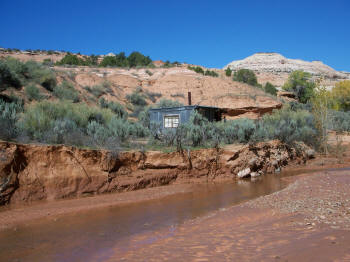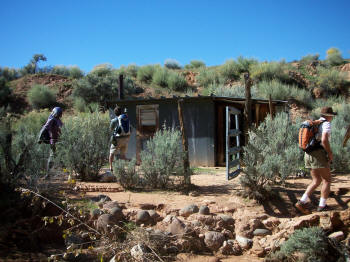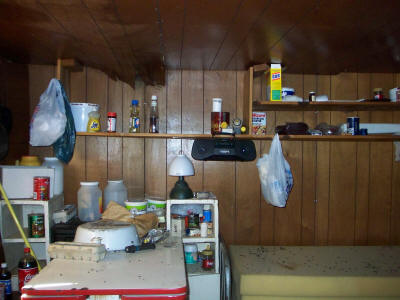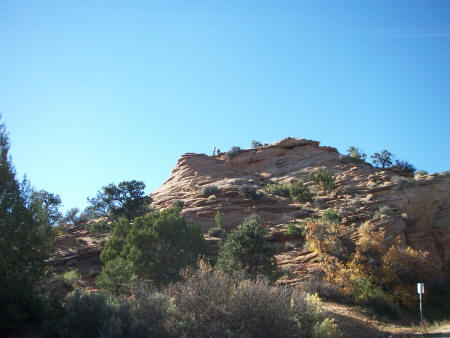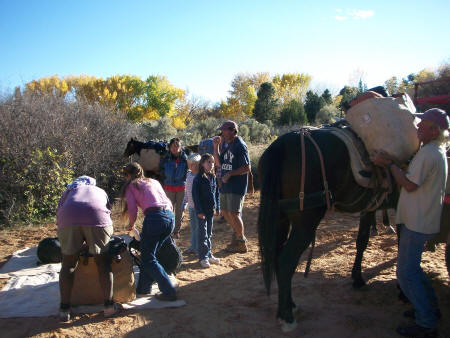|
Escalante National Monument Trip
One day in the spring of 2006, I was killing time in a library in Bloomfield Hills while Carol was attending a neurofeedback meeting and I saw an article about a new trip in the Utah canyon country conducted by Escalante Canyon Outfitters (www.ecohike.com). When we got home, I made a reservation for the Waterpocket Fold trip, October 15-20.
I flew to Salt Lake City on Saturday, October 14 and met fellow camper Nancy Maruyama at the Enterprise Rental Car counter. We rented a car and drove to Boulder, a 5-hour trip. Nancy didn’t have a motel reservation, so Sue Fearon, who owns ECO with husband Grant Johnson, arranged for her to stay in the home of Tina, who sometimes works as a guide for ECO. I stayed at the Circle Cliffs Motel.
After breakfast at the Hell’s Backbone Grill next to the Boulder Mountain Lodge, Nancy and I drove to the ECO headquarters (next to the Sinclair station), where we met owner Sue Fearon, guide Serena ? and the other 6 campers.
Note: Some of the photos you will see in this story were contributed by fellow campers Chuck Pease, Judy Hudson and Nancy Maruyama. Where no credit is given, the photo is mine. You can see larger versions of my photos by clicking the photos in the story.
Chuck's Photo We moved our stuff from our suitcases to duffle bags and then prepared sandwiches for lunch from sliced meats, cheese, lettuce and tomato that had been set out for us. The sandwiches went into rigid plastic containers. We also filled zip-lock bags with trail mix and dried fruit. This was to be the after-breakfast routine every day of the trip. The lunches went into our daypacks, and we were also to fill our Camelbaks and water bottles. I didn’t hear this last instruction, and although I had a full plastic water bottle, I neglected to fill my 3-liter Camelbak. I thought we’d be making an easy 4-mile hike to the campsite.
After all our stuff was loaded into the van, we followed it down Burr Trail to Tina’s house, where we left our cars. We continued down Burr Trail in the van to the trailhead for the Deer Creek Trail. In the photo at the left, starting at the left, it is me, Sally Gall, Judy Hudson, Nancy Maruyama, Serena, Cynthia Van, Chuck Pease, Nancy K and Eric Epstein. We put on our backpacks and headed down the trail along a small creek that was rushing with muddy water. They had gotten 5 inches of rain in the last week, in a part of the country where the average for a year is 7, so our original Waterpocket Fold trip was called off. Instead, we would camp on higher ground. (Sister Laura and I would do the Waterpocket Fold trip in April 2007.) Soon it was necessary to cross the stream, which was about 6 feet wide. Eric (late thirties?) and Chuck (65) were always the leaders in these difficult situations. Eric made the jump using his hiking stick, then, while demonstrating for the rest of us, slipped on the bank and fell head first into the stream. No harm, although I was afraid the current was going to pull off his glasses. Only his upper body got wet.
An hour or so later, we met Grant Johnson, who owns ECO with wife Sue Fearon, and Doug Campbell, a guide, with their six horses. They were coming back from having delivered the stoves and other heavy camping equipment to the campsite. They would continue back to the trailhead where they would load up our duffle bags, tents, and sleeping bags.
Besides not having enough water, I was wearing a long-sleeved shirt, and was soon sweating. I took it off and put it in my backpack. I was also carrying binoculars around my neck. That was the last day I did that.
Serena had not been to this new campsite, so was going by Grant’s directions on how to get there. At one point, she led us up a slick rock incline that was not the easiest route. It was too high and steep for the less experienced hikers, which included all of us except Chuck, Cynthia, Eric and Nancy K. Chuck and Cynthia went right up, while some of the rest of us – including me – began to panic. Eric helped us get to a spot that had less of an incline, and Serena had us stay put while she went looking for the horse trail.
After about an hour, during which time we ate lunch and I began suffering leg cramps – probably from not having enough water – we heard Serena’s call from a long distance away. Since she is black and was wearing dark clothing, I couldn’t see her, even with my binoculars, but eventually someone did. We went down off the rock and caught up with her on level, sandy ground. We didn’t know it at that time, but our camp was at the base of the chopped-off peak in the distance in the picture below. Our campsite was a beautiful spot high on slick rock next to a large sandy area. There were several small ponds in the rock that would have been much smaller had it not rained so much the previous week. While Serena was cooking dinner, we put up our tents. Nancy M and I put ours on the slick rock, hers up on a hill. Mine is at the right, below. The others wisely found spots on the sand. Grant and Doug eventually arrived with our duffle bags. The meals were wonderful all week. Dinner began with Franzia wine and appetizers: cheese cubes, crackers, chips and dip. The first night, the entrée was fried trout. Other nights we had chicken basil; spaghetti with meat sauce, carrot salad and garlic bread; and steak fajitas. Desserts included fresh baked chocolate chip cookies, brownies, and apple crisp with real whipped cream. For breakfasts, we had eggs made-to-order, blueberry pancakes with blue corn flour, French toast, and fresh fruit. Also bacon and sausage. In addition, meatless meals were prepared for Chuck and Cynthia, who are vegans. We ate like kings, but on our laps. There was no table; just camp chairs. Most nights we got back from our hikes so late that we had to eat by the light of our headlamps. The toilet was a deep hole in the sand with a toilet seat propped over it. A tarp provided privacy. A plastic container of liquid soap and a suspended bag of water allowed us to wash our hands. My first night sleeping on the rock was surprisingly comfortable, thanks to the Thermarest pad provided by ECO. I didn’t have a pillow, though; the best I could devise was a folded towel wrapped up in my jacket. The next day, Grant told me I’d better move my tent so that I could tie it to something to keep it from blowing away. I moved it to a small sandy spot next to a juniper, not far from my original site. The move off the rock also allowed me to use my tent stakes. We also moved Nancy M off the rock hill to a sheltered sandy area. The move was just in time: that night, we had wind and rain. I kept dry, but the noise of the wind blowing the tent flaps made it difficult to sleep. That was the only rain we had all week. It got cold at night, as low as 26 degrees just before dawn one day. I was warm in my sleeping bag – so warm I usually slept nude - but had to bundle up to crawl out and pee in the middle of the night. That was no fun, and the temptation was to put it off. But it was soon clear that there would be no sleep until the matter was taken care of. I would put on long underwear, jeans, shirt and boots by the light of my headlamp, then walk a few yards from the tent, turn off the headlamp, and look at the stars.
In the morning, we’d put on our warmest clothes for breakfast, but by the time breakfast was finished and lunches were packed (around 10:00), it was warm enough that we could strip back to just jeans (or shorts) and a T-shirt. We hiked each day, all of us together. We had the option of staying around camp, but no one did. We also had the option of heading back early with Serena, who had to get dinner started. That was tempting: wandering around within a mile of camp would have provided all kinds of neat things to see, and would have been much less strenuous. But no one wanted to miss out on the adventure Grant might have planned for us.
We saw beautiful rock formations everywhere:
We saw Moki (or Moqui) marbles by the thousands. Moki is a word for the ancient Indians, or Anasazi, who inhabited the southwest. Moki marbles really had nothing to do with the Indians; they are just peculiar round, black stones that somehow get created from Moki iron.
In the ponds, we saw what we first thought were tadpoles, but which turned out to be triops, the oldest living animal species on earth. They look like miniature horseshoe crabs. I knew they weren’t tadpoles or insects; Grant knew they were triops. Here is how triops are described in Wikipedia:
We saw petroglyphs only once, although Grant seemed to know of other locations. We saw dinosaur tracks. Grant seemed to know what kind of rock they’d be found in. We explored caves with ceilings blackened by the smoke of ancient campfires. On more than one occasion, we found metates and manos. The metate is a rock into which the Anazasi carved a shallow bowl. The mano is a rounded stone they used to grind maize (corn) in the metate. We saw balancing rocks: The canyons and slickrock hills are Grant’s place of work and has been his playground for years. He knows his way around and he knows the vegetation, animals, artifacts and signs of early Indians, and the geologic forces that created the landscape over millions of years. He has canoed the streams and he has used a pickaxe to cut horse trails in steep rock.
Near the end of one hike, we were close to the top of the tower that overlooks our campsite. Grant, Eric and Chuck made the difficult climb all the way to the top while the rest of us continued on to the camp with Doug. This is why I didn't go with them:
This is their view of our camp from the top of the tower. The photo at the right is zoomed in.
That afternoon (Wednesday) was also when the shower was fully set up and ready. It was a big bucket suspended from a branch with a rope. A showerhead with a shutoff was attached to the bottom of the bucket, and the bucket could be lowered so that it could be filled. Showers were by appointment. Serena would heat a bucket of water and bring it to the shower along with a bucket of cold water. She’d pour in the hot first, then add cold until the temperature was to the customer’s satisfaction. She’d then raise the shower bucket up and tie it off. I took my first and only shower that night, although I’d washed my face and hair in a bucket of cold water the night before. I did not miss bathing and the first time I saw my unshaven face was in the window of the van at the end of the trip.
Nancy K also showered and Eric claimed that he spied on her from atop the tower. It was often necessary to cross streams on our hikes, and although we constructed a bridge once, we usually had to wade. To avoid getting our hiking boots wet, we carried special wading footwear or old sneakers. The water was painfully cold. All photos except lower right are Chuck's One morning before sunrise I heard something fly by my tent and didn’t realize what it could be until I looked out and saw geese or ducks on the big pond nearby. They flew off before I could get a good look. They made no noise except for the sound of their wings.
We saw tracks of mule deer and coyote and maybe some kind of cat – too small for mountain lion. We saw ravens, hawks and LGBs – little gray birds. Here and there we saw freshly dug piles of sand (above). Grant said it was from gophers, but there was no hole – just the pile of dirt. Puzzling.
One long hike got us to a very high spot where we had a grand view of the surrounding countryside. At the left above in the distance are the snow-capped Henry mountains. When we started down, we saw Eric down below taking a skinny dip in a pool. I wasn’t quick enough with my camera to catch him in full undress. Along creeks at the bottom of ravines, we sometimes sunk to our ankles in quicksand. Grant suggested that we wear hats so he would have something to give our families. I believe that is sagebrush in the photo at the right below. Someone had told me that the aspen leaves would be bright yellow this time of the year, but as it turned out, aspen are only at higher elevations and they had already dropped their leaves. The cottonwood leaves were yellow, however. Back at camp late one afternoon, there was a rainsquall to the east: Except for some small knee scrapes, I survived without injury, and except for blisters, so did everyone else. Here is Doug putting a bandage on Judy’s foot. It was quite a remarkable group. Nancy M, Judy and Sally were all from Manhattan. Nancy is a psychiatrist who works with people with serious illnesses like cancer. Judy is a painter (www.judyhudson.net). Nancy K is in charge of historical markers for the state of Maryland, where she and Eric live. Sally is a professional photographer (www.sallygall.com). Eric is involved in making films for the National Park Service.
Cynthia and Chuck are Air Force retirees, trekkies, and spelunkers (cave explorers). They live in Prescott, Arizona. Serena lives in Boulder. She learned to cook working in a restaurant. Besides working as cook and guide for ECO, she does stone masonry.
Doug Campbell works in construction when he is not working as a guide for ECO. He lives in Teasdale, Utah. He knitted socks on our lunch breaks. He said it was an alternative to smoking.
On our way out on the last day, we came upon a cowboy cabin. It was locked up, but a window had a hole big enough to peek into. Still, it was dark inside. I stuck my camera in the hole and took a picture with the flash on. I didn’t realize how good it came out until I got home. When we got back to the trailhead at 3:00 Friday, Sue Fearon was waiting for us, but we had to wait another 2 hours for Grant and Doug to get there with our stuff. While we were waiting, Sue told us about the home she and Grant were building. They were using dynamite to hollow out a big rock that was shaped like half an egg. She also told us how great it was to live in a community where it was safe to allow kids to freely roam around. While she was saying this, her 10-year old daughter Claire and a friend and a dog were scampering up a nearby rock hill. After they’d been up and down and all round it at least twice, Sue noticed and yelled at them, telling them not to get too close to the edge. Finally, the horses arrived with our stuff. We said our goodbyes and went our separate ways. |
